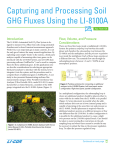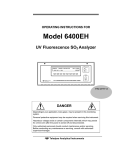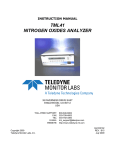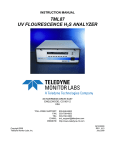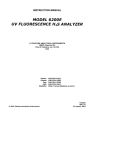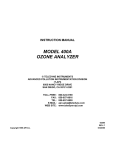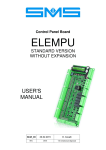Download NumaView™ Software Interface Addendum
Transcript
NumaView™ Software Addendum to T-Series Manuals © TELEDYNE ADVANCED POLLUTION INSTRUMENTATION (TAPI) 9480 CARROLL PARK DRIVE SAN DIEGO, CALIFORNIA 92121-5201 USA Toll-free Phone: Phone: Fax: Email: Website: Copyright 2015 Teledyne Advanced Pollution Instrumentation 800-324-5190 858-657-9800 858-657-9816 [email protected] http://www.teledyne-api.com/ 08296A DCN7130 04 August 2015 NOTICE OF COPYRIGHT © 2015 Teledyne Advanced Pollution Instrumentation. All rights reserved. TRADEMARKS All trademarks, registered trademarks, brand names or product names appearing in this document are the property of their respective owners and are used herein for identification purposes only. This product is based on technology licensed from Aerodyne Research, Inc. 08296A DCN7130 Teledyne API NumaView™ Software Addendum i This page intentionally left blank. 08296A DCN7130 Teledyne API NumaView™ Software Addendum ii TABLE OF CONTENTS Table of Contents ..........................................................................................................................................iii List of Figures ............................................................................................................................................... iv 1. INTRODUCTION ...................................................................................................................................... 5 2. INTERFACE ORIENTATION: T-SERIES LEGACY-TO-NUMAVIEW™ SOFTWARE ........................... 6 2.1. Switching Between Software Interfaces............................................................................................... 11 3. WHAT’S NEW ........................................................................................................................................ 11 3.1. Improved Menu .................................................................................................................................... 11 3.2. Setup Options ...................................................................................................................................... 11 3.3. Gas and Concentration Display ........................................................................................................... 12 3.4. Configurable Displays, Alerts, and Events ........................................................................................... 13 3.4.1. Dashboard ................................................................................................................................ 13 3.4.2. Alerts ......................................................................................................................................... 13 3.4.3. Events ....................................................................................................................................... 13 3.5. Data Log ............................................................................................................................................... 14 4. ANATOMY OF THE NUMAVIEW™ SOFTWARE INTERFACE ........................................................... 14 4.1. Home .................................................................................................................................................... 14 4.2. Dashboard ............................................................................................................................................ 15 4.3. Alerts .................................................................................................................................................... 16 4.4. Calibration ............................................................................................................................................ 17 4.5. Utilities .................................................................................................................................................. 18 4.5.1. Datalog View ............................................................................................................................. 18 4.5.2. Alerts Log .................................................................................................................................. 19 4.5.3. USB Utilities .............................................................................................................................. 19 4.5.4. Diagnostics ............................................................................................................................... 20 5. SETUP ................................................................................................................................................... 20 5.1. Data Logging ........................................................................................................................................ 21 5.1.1. Creating a User-Defined Data Log ........................................................................................... 22 5.1.2. Configuring Trigger Types ........................................................................................................ 23 5.1.2.1. Periodic Trigger ............................................................................................................ 23 5.1.2.2. Conditional Trigger ....................................................................................................... 24 5.1.3. Downloading DAS Data ............................................................................................................ 24 5.2. Events .................................................................................................................................................. 25 5.2.1. Creating User-defined Events ................................................................................................... 26 5.2.2. Editing or Deleting Events......................................................................................................... 26 5.3. Dashboard ............................................................................................................................................ 27 5.4. Auto Cal ............................................................................................................................................... 27 5.5. Vars ...................................................................................................................................................... 28 5.6. Homescreen ......................................................................................................................................... 28 5.7. Digital Outputs ...................................................................................................................................... 29 5.8. Analog Outputs .................................................................................................................................... 29 5.9. Instrument ............................................................................................................................................ 32 5.9.1. Instrument Date/Time Adjustments .......................................................................................... 32 5.9.2. Instrument Display Calibration .................................................................................................. 33 5.10. COMM (Communications) ................................................................................................................. 34 6. FIRMWARE UPDATES ......................................................................................................................... 35 7. QUICK REFERENCE MENU STRUCTURE ......................................................................................... 37 08296A DCN7130 Teledyne API NumaView™ Software Addendum iii LIST OF FIGURES Figure 1. Gas Concentration Display and Graphs ...................................................................................... 12 Figure 2. Dashboard ................................................................................................................................... 13 Figure 3. Home Screen ............................................................................................................................... 14 Figure 4. Concentration and Stability Graph and Meter Graph .................................................................. 15 Figure 5. Dashboard Page .......................................................................................................................... 15 Figure 6. Navigating to the Active Alerts Page ........................................................................................... 16 Figure 7. Active Alerts Cleared ................................................................................................................... 17 Figure 8. Multipoint Calibration Page .......................................................................................................... 17 Figure 9. Calibration Span Target Page ..................................................................................................... 18 Figure 10. Editing Calibration Span Target ................................................................................................. 18 Figure 11. Alerts Log ................................................................................................................................... 19 Figure 12. USB Utility Page ........................................................................................................................ 19 Figure 13. Configuration Pop-up Examples ................................................................................................ 20 Figure 14. Scrollable List Indicators ............................................................................................................ 21 Figure 15. Datalog Configuration, New Log Page ...................................................................................... 21 Figure 16. Datalog Configuration, Editing an Existing Log ......................................................................... 21 Figure 17. Datalog Configuration ................................................................................................................ 22 Figure 18. Datalog Periodic Trigger Configuration ..................................................................................... 23 Figure 19. Datalog - Conditional Trigger Configuration .............................................................................. 24 Figure 20. DAS Data Utility ......................................................................................................................... 24 Figure 21. Events List ................................................................................................................................. 25 Figure 22. Event Configuration ................................................................................................................... 26 Figure 23. Existing Event for Viewing or Editing ......................................................................................... 26 Figure 24. Dashboard Configuration ........................................................................................................... 27 Figure 25. Auto Cal Configuration Page ..................................................................................................... 27 Figure 26. Vars Configuration Page ............................................................................................................ 28 Figure 27. Home Configuration ................................................................................................................... 28 Figure 28. Digital Outputs Setup ................................................................................................................. 29 Figure 29. Analog Outputs Menu ................................................................................................................ 30 Figure 30. Analog Output Configuration Page ............................................................................................ 30 Figure 31. Analog Output Auto Calibration Page ........................................................................................ 31 Figure 32. Analog Output Manual Calibration Page ................................................................................... 31 Figure 33. Instrument System Information Page ........................................................................................ 32 Figure 34. Date and Time Configuration Page ........................................................................................... 32 Figure 35. Touchscreen Calibration Page .................................................................................................. 33 Figure 36. Communications Configuration Page ........................................................................................ 34 Figure 37. COM1 and COM2 Protocol Selection ........................................................................................ 34 Figure 38. Network Configuration Page ...................................................................................................... 34 08296A DCN7130 Teledyne API NumaView™ Software Addendum iv 1. INTRODUCTION This addendum is intended to provide an orientation to the new, NumaView™ software interface; it does not provide operational instructions, which are already covered in the instrument’s user manual. The interface pages are self-explanatory and easy to operate, although some details are provided herein. This addendum focuses on what’s new and different in the software, starting with a general orientation that maps the T-Series legacy software interface to the NumaView™ software interface, and then describes some of the new features in detail. Please note that at the time of this writing the NumaView™ software is not yet EN/US EPA approved. When the instrument is first powered on, it performs a dual boot-up that allows a choice to switch between the T-Series legacy software interface and the NumaView™ software interface. The default initial boot displays the T-Series legacy software interface for running your instrument as certified, and any boot thereafter opens to the last software interface used. See Section 2.1 for instructions on switching between the two interfaces. The NumaView™ software interface facilitates a more in-depth view of instrument status and readings in real time, including quick-view graphs; it also displays three additional readings of user-selected parameters for immediate view in “meters” located below the gas concentration display. The interface allows user configuration of many parameters, and includes brief help notes that provide descriptions and instructions for the editable parameters. This addendum is structured as follows: Section 2, “Interface Orientation: T-Series Legacy-to-NumaView™ Software,” compares the two interfaces to assist with navigation to familiar operations and functions. Section 3, “What’s New,” describes new features of the NumaView™ software. Section 4, “Anatomy of the NumaView™ Software Interface,” delivers further information regarding the new software interface pages. Section 5, “Setup,” provides details for setting up or viewing features, operations and functions significantly enhanced from the T-Series legacy software. Section 6, “Firmware Updates,” lists steps for updating firmware. 08296A DCN7130 Teledyne API NumaView™ Software Addendum 5 2. INTERFACE ORIENTATION: T-SERIES LEGACY-TO-NUMAVIEW™ SOFTWARE The following table provides a high-level comparison of the two interfaces. Component T-Series Legacy Software Interface NumaView™ Software Interface Home Page, Sample Mode Navigation Press the Setup button Setup Menu. to go the Primary Press the More button Secondary Setup Menu. to go to the Press the sidebar tabs to go to the corresponding menus. Press the Home button, shortcut to the home screen. Press the EXIT button to back out to each preceding screen, one at a time. Or keep the current display active and back out to each preceding menu in the sidebar by pressing the double arrow button. Fault/Alert Indicator Red FAULT LED blinking in upper left area of display and MSG/CLR buttons active Caution symbol for Alerts in lower right corner of display Read Fault/Alert messages Read each Fault message one at a time: press MSG button Read all Alerts in one display: either press Caution symbol (shortcut) or press Alerts tab: 08296A DCN7130 Teledyne API NumaView™ Software Addendum 6 Component Clear Fault messages T-Series Legacy Software Interface Press CLR button serially to clear Faults one at a time. NumaView™ Software Interface Either press individual boxes to choose specific Alerts to clear or press Select All box to choose all Alerts, then press Clear Selected button Functional Checks When all messages are cleared, the Fault LED is no longer lit: When all Alerts are cleared, the bottom right Caution symbol is replaced by a green LED: View the Test parameters, one at a time, by pressing the TST TST buttons to scroll the list View many parameters and their values a page at a time, by pressing the Dashboard button. (See “Anatomy of the NumaView™ Software Interface” for details on selecting parameters to be displayed). Calibration Press to start calibration. Press , , then for multi-point (M-P) calibration (M-P is the default; to access the Span and Zero menus, either the IZS or Z/S option is required). Sample Mode (Home screen) (See “Anatomy of the NumaView™ Software Interface” for details) 08296A DCN7130 Teledyne API NumaView™ Software Addendum 7 Component T-Series Legacy Software Interface Setup Mode Press the Setup button Setup menu to go to the Primary NumaView™ Software Interface Press the Setup button single Setup menu. to go to the Scroll the Setup menu Press the MORE button Secondary Setup menu Analyzer Configuration > to get to the > (model, hardware, and software info) 08296A DCN7130 Teledyne API NumaView™ Software Addendum 8 Component DAS – internal Data Acquisition System T-Series Legacy Software Interface > NumaView™ Software Interface > (to edit/add DAS parameters) Downloading DAS data is accomplished through the Utilities>USB Utilities menu. RNGE Configure analog output reporting range > > PASS Calibration and Setup Passwords 08296A DCN7130 > Password no longer applies for Setup and Calibration menus. Teledyne API NumaView™ Software Addendum 9 Component T-Series Legacy Software Interface CLK Configure clock: time and date NumaView™ Software Interface > > > COMM Configure external communication > > > See “Anatomy of the NumaView™ Software Interface” for details. VARS System configuration variables > > > > DIAG System diagnostic features and analog output configuration 08296A DCN7130 > > (Diagnostics menu appears in the sidebar, while current display remains until a diagnostics parameter is selected). Teledyne API NumaView™ Software Addendum 10 2.1. SWITCHING BETWEEN SOFTWARE INTERFACES As first shipped from the factory, the instrument initially boots to the T-Series legacy software interface. To switch between interfaces, connect a personal computer standard USB keyboard to a front panel USB port, and power-cycle the instrument while doing one of the following: Hold the “n” key during power-on to boot to the NumaView™ software. Hold the “t” key during power-on to boot to the legacy T-Series software. Powering on without holding any key boots to the software that was in use prior to last power-off. 3. WHAT’S NEW This section provides a general description of new and improved features. Finer details are presented in Section 4, “Anatomy of the NumaView™ Software Interface.” 3.1. IMPROVED MENU Not only is the menu simpler, but also navigation is more efficient. The current menu remains visible on the left side of the interface. Instead of “exiting” multiple menu depths one level at a time, the Home shortcut jumps immediately to the home page from anywhere in the interface. The home page is comprised of the Main menu list, the gas and concentration display, and three meters showing the readings of user-selected parameters. If the menu is two or more levels deep, the back-arrow button returns the menu list to the preceding level without leaving the current display. See Section 6 for a break-out of the menu structure. If there is information available about a page or a component, the information button at the top of the interface is white ; otherwise, it is grayed out . The log-in button is used for entry into protected areas of the menu system; contact TAPI Technical Support regarding this feature. 3.2. SETUP OPTIONS The context sensitive configuration button is used to customize configurable pages, such as Home and Dashboard, and configurable parameters such as Digital Outputs under the Utilities>Diagnostics menu. When in use or not available, this button is grayed out . Other parameters are set up through their respective menus, as described later in Section 5. 08296A DCN7130 Teledyne API NumaView™ Software Addendum 11 3.3. GAS AND CONCENTRATION DISPLAY This field of the interface shows the gas name(s) and respective concentration(s). In addition to the real-time read-outs, pressing the gas name or its value in this screen brings up a graph plotting the concentration and stability values. Below the gas and concentration display are three meters for concurrent display of other selectable parameter readings (Section 5.6 provides instructions for configuring these meters). Pressing a meter can also display a graph of the parameter. Figure 1. Gas Concentration Display and Graphs 08296A DCN7130 Teledyne API NumaView™ Software Addendum 12 3.4. CONFIGURABLE DISPLAYS, ALERTS, AND EVENTS Several features can be customized to suit user needs. 3.4.1. DASHBOARD The dashboard displays an array of user-selected parameters and their values (Figure 2). If there is a graphing icon in the upper right corner of a parameter, pressing that parameter displays a plot. Dashboard configuration details are presented in Section 5.3. Three of the dashboard parameters can be selected for continuous display in the meters located in the lower portion of the Home page. Homescreen configuration is presented in Section 5.6. Figure 2. Dashboard 3.4.2. ALERTS Alerts and Events are closely related. The Alerts screen shows the status of any active warning conditions or user-configured events. Details are presented under “Anatomy of the NumaView™ Software Interface” in Section 4.3. 3.4.3. EVENTS Events are used to define the conditions that will trigger Alerts. Events can provide diagnostic information about the instrument, typically referred to as “Warnings”, or they can provide additional instrument functionality, such as concentration alarms. The instrument comes from the factory with a number of pre-defined warning events (comparable to Warnings in the T-Series legacy software), and the NumaView™ software interface provides the capability to create additional, user-defined events. Event configuration details are presented in Section 5.2. Events can also be used to create customized triggers for data logging functions (detailed in Section 5.1). 08296A DCN7130 Teledyne API NumaView™ Software Addendum 13 3.5. DATA LOG Like the legacy T-Series internal Data Acquisition System (DAS), this userconfigurable data logger tracks and reports instrument data based on configurable periodic timers or event-based triggers for user-selected parameters (see Section 5.1). 4. ANATOMY OF THE NUMAVIEW™ SOFTWARE INTERFACE This section provides pictorial documentation of some features of the new NumaView™ software interface; it does not go into granular detail as there are descriptions and instructions in the interface itself. For features whose setup and/or operation are not new and have not changed, the instrument manual still applies. 4.1. HOME Figure 3. Home Screen Figure 4 shows that pressing the gas name or its concentration value or a meter below displays a plot of the respective values. Note that not all meters are graphed, as explained next in Section 4.2. 08296A DCN7130 Teledyne API NumaView™ Software Addendum 14 Figure 4. Concentration and Stability Graph and Meter Graph 4.2. DASHBOARD From the Home page, pressing the Dashboard menu displays an array of userselected parameters and their readings, which may flow onto more than one page. (See Section 5.3 for configuration details). The graphing icon indicates parameters whose reading can be displayed as a plot when the parameter is touched. Figure 5. Dashboard Page 08296A DCN7130 Teledyne API NumaView™ Software Addendum 15 4.3. ALERTS Alerts (introduced in Section 3.4.2) are notifications of Events that have been triggered (introduced in Section 3.4.3). While some Events are standard, others can be specified for Alerts in the Setup> Events Configuration page (Section 5.2). When Alerts are triggered, a caution symbol appears in both the Alerts tab and in the bottom right corner of the interface. A list of currently active Alerts can be viewed from Alerts menu accessible from the Home page or by pressing the Alerts icon short cut (Figure 6). A history of Alerts, both current and past, is displayed in the Alerts Log under the Utilities tab (Section 4.5.2). Figure 6. Navigating to the Active Alerts Page 08296A DCN7130 Teledyne API NumaView™ Software Addendum 16 In the Active Alerts page, select any or all alerts and clear them from the Active Alerts page by pressing the Clear Selected button. When all alerts are cleared, the Alerts tab no longer shows the caution symbol, and a green LED replaces the caution symbol in the bottom right corner of the interface (Figure 7). However, this does not delete the history of alerts (Section 4.5.2). Figure 7. Active Alerts Cleared 4.4. CALIBRATION The Calibration menu provides Multi-Point (M-P) calibration. To run Span Calibration, at least one option must be installed: O3 Generator, O3 Gen Ref Detector, or Zero Span valve. To run Zero Calibration, the analyzer must have any of those options or the the IZS valve option installed. Consult the instrument user manual for calibration information. The M-P Calibration page graphs the concentration and the stability. Once the Start button is pressed, various buttons may be enabled, depending on what calibration functions are currently allowed. Figure 8. Multipoint Calibration Page 08296A DCN7130 Teledyne API NumaView™ Software Addendum 17 Figure 9. Calibration Span Target Page To change the span target concentration, press the Set Span Target button. Then press the button showing the current setting . A numeric keyboard appears along with a field showing the current entry; press the numeric keys to edit. Figure 10. Editing Calibration Span Target 4.5. UTILITIES The Utilities menu opens to the Datalog View, the Alerts Log, the USB Utilities, and the Diagnostics submenus. 4.5.1. DATALOG VIEW The Datalog View tab displays a list of data logs that were configured in the Setup>Data Logging tab. From this list a log can be selected and filters applied to view the desired data. Refer to Section 5.1 for details. 08296A DCN7130 Teledyne API NumaView™ Software Addendum 18 4.5.2. ALERTS LOG The Alerts Log (Figure 11) displays a history of alerts that are triggered by factory-defined and user-defined Events, such as warnings and alarms. Figure 11. Alerts Log See Sections 3.4.2 and 4.3 for more information. 4.5.3. USB UTILITIES The USB Utility page serves multiple purposes using a flash drive connected to the instrument’s front panel USB port. One purpose is transferring Data Acquisition System (DAS) data from the instrument to a flash drive. Section 5.1.3 provides instructions. Another is updating firmware. Section 6 provides instructions. (A third purpose, which is not yet available, is copying a configuration from one instrument to other instruments). Figure 12. USB Utility Page 08296A DCN7130 Teledyne API NumaView™ Software Addendum 19 4.5.4. DIAGNOSTICS The Diagnostics tab provides access to analog and digital inputs and outputs, and to calibration menus. The interface for each menu item is self-explanatory. Consult the instrument user manual for their applications and uses. 5. SETUP The Setup tab in the Home page opens a submenu to either configure various programmable features or to view their current configurations and states. Once Setup is complete, the saved configurations can be downloaded to a USB drive and uploaded to other instruments. Section provides instructions. Setup tasks are facilitated by any of various pop-ups that appear for naming, describing, and programming the available parameters. For example, a keyboard or a list of choices will appear when a blank field is pressed, as shown in Figure 13. Figure 13. Configuration Pop-up Examples Note that scrollable lists, such as some menus and parameter selections, are indicated by a gray bar on the right side of the list. Figure 14. Scrollable List Indicators shows examples. Drag the list to scroll. 08296A DCN7130 Teledyne API NumaView™ Software Addendum 20 Figure 14. Scrollable List Indicators 5.1. DATA LOGGING The Data Logger is the counterpart to the legacy T-Series DAS (consult the instrument user manual for DAS details), including a new trigger type called Conditional (track and log parameters that meet user-defined conditions). Configure the data logger via the Home>Setup>Data Logging menu; press the ADD button to create a new log (Figure 15), or select an existing log from the Data Logging list and press the EDIT or DELETE button to make the desired changes (Figure 16). See Sections 5.1.1 and 5.1.2 for configuration details. See Section 5.1.3 for transferring captured DAS data between the instrument and a flash drive. Figure 15. Datalog Configuration, New Log Page Figure 16. Datalog Configuration, Editing an Existing Log 08296A DCN7130 Teledyne API NumaView™ Software Addendum 21 5.1.1. CREATING A USER-DEFINED DATA LOG Figure 17. Datalog Configuration 08296A DCN7130 Teledyne API NumaView™ Software Addendum 22 5.1.2. CONFIGURING TRIGGER TYPES 5.1.2.1. PERIODIC TRIGGER The Periodic trigger is a timer-based trigger that is used to log data at a specific time interval. Periodic Trigger requires an interval that is set to number of minutes and a start time that is set to date and time. Figure 18. Datalog Periodic Trigger Configuration 08296A DCN7130 Teledyne API NumaView™ Software Addendum 23 5.1.2.2. CONDITIONAL TRIGGER Conditional Trigger tracks/records data for user-selected parameters that meet specified conditions. Figure 19. Datalog - Conditional Trigger Configuration 5.1.3. DOWNLOADING DAS DATA In the Utilities>USB Utilities menu DAS data can be downloaded from the instrument to a flash drive, as presented here. (Refer to the instrument’s user manual for details about DAS). Figure 20. DAS Data Utility 1. Press USB Utilities menu to open the utility page (Figure 20). 2. Insert a flash drive into a front panel USB port and wait for the Status field to indicate that the drive has been detected and available buttons are enabled. 08296A DCN7130 Teledyne API NumaView™ Software Addendum 24 3. To copy the data to the flash drive, press the Start button next to “Download DAS Data from Instrument.” (The Cancel button will be enabled). 4. When complete, as indicated in the Status field, the Cancel button becomes the Done button, which you can press and then remove the flash drive. 5.2. EVENTS Events are occurrences that relate to any operating function, and will trigger Alerts (Section 4.3). Some Events are standard and not editable while others are user-configurable; creating and editing user-defined events are depicted next. Figure 21. Events List 08296A DCN7130 Teledyne API NumaView™ Software Addendum 25 5.2.1. CREATING USER-DEFINED EVENTS In the Home>Setup>Events menu (Figure 21) press ADD to create a new Event. Figure 22 depicts what to do next. The Enabled box allows the choice of whether to track and record the Event. The Visible box allows the choice of whether or not to display the Event in the Alerts tab when it is triggered, although it will still be recorded. The third box allows the choice of whether or not to make it a Latching Event. Figure 22. Event Configuration 5.2.2. EDITING OR DELETING EVENTS Select an Event from the list (Figure 21) and press the EDIT button to view or edit the details (Figure 23). To delete an Event, select the Event from the list and press the DELETE button. Figure 23. Existing Event for Viewing or Editing 08296A DCN7130 Teledyne API NumaView™ Software Addendum 26 5.3. DASHBOARD Go to the Dashboard Configuration page either from the Dashboard page by pressing the configuration button (shortcut), or from the Setup>Dashboard menu. To add a parameter for display in the Dashboard, make a selection from the “Available Tags” column and press the right-pointing button . To remove a parameter from the Dashboard, select a tag from the ”Dashboard” column and press the left-pointing button . Figure 24. Dashboard Configuration 5.4. AUTO CAL Auto Cal is only available when the IZS or Z/S valve option is installed. To set up Automatic Calibration, make your choices and provide your Start, Interval, and Duration times in the SETUP>Auto Cal page. Refer to your analyzer’s user manual for information on auto cal. Figure 25. Auto Cal Configuration Page 08296A DCN7130 Teledyne API NumaView™ Software Addendum 27 5.5. VARS The Vars configuration page allows selecting a Variable and pressing the Edit button to change its values or conditions. Refer to your analyzer’s user manual for information on Vars. Figure 26. Vars Configuration Page 5.6. HOMESCREEN Configuring the Homescreen involves selecting a parameter to display in each of the three meters located below the gas concentration field. From the Setup>Homescreen menu (Figure 27), scroll through the list of available tags and select one, then touch a meter to apply. Repeat for the other two meters. Home Configuration can also be reached by shortcut: while in the Home page, press the context-sensitive configuration button . Figure 27. Home Configuration 08296A DCN7130 Teledyne API NumaView™ Software Addendum 28 5.7. DIGITAL OUTPUTS One of the new features of the new NumaView™ software interface is userconfigurable Digital Outputs (formerly called Status Outputs). The mapping of the function of each Digital Output can be specified by the user, and the Output can be mapped to a wide variety of “Signals” present in the instrument. In addition, users can create their own custom “Signals” using Events (Section 5.2). To map Digital Outputs to Signals, select a pin in the Outputs list, then make a selection from the Signals list and press the Map button; if needed, change the polarity by pressing the Polarity button. Save any changes by pressing the Apply button or discard the changes by instead pressing the Home button (a pop-up provides a warning that the changes will be lost, and will prompt for confirmation to apply changes or not). Figure 28. Digital Outputs Setup 5.8. ANALOG OUTPUTS One of the new features of the new NumaView™ software interface is userconfigurable Analog Outputs. The mapping of the function of each Analog Output can be specified by the user, and the Output can be mapped to a wide variety of values (or “Signals”) present in the instrument. The Setup>Analog Outputs menu provides a choice among four analog outputs and an analog output calibration. Note that the last page on display prior to going to the Analog Outputs menu remains until one of the choices is selected. 08296A DCN7130 Teledyne API NumaView™ Software Addendum 29 Figure 29. Analog Outputs Menu Each of the Outputs can be configured by pressing the Output, selecting an option from a list, and choosing or entering a value for each field. Refer to your analyzer’s user manual for details on analog outputs. Figure 30. Analog Output Configuration Page 08296A DCN7130 Teledyne API NumaView™ Software Addendum 30 Calibrate analog outputs by pressing Analog Output Calibration; for automatic calibration (default), press the Start button. Figure 31. Analog Output Auto Calibration Page If an Analog Output was assigned Manual Calibration Type, press the AUTO button and select the Output to manually calibrate and adjust values as necessary. Figure 32. Analog Output Manual Calibration Page 08296A DCN7130 Teledyne API NumaView™ Software Addendum 31 5.9. INSTRUMENT The Instrument page shows product information and configurable instrument settings. Figure 33. Instrument System Information Page 5.9.1. INSTRUMENT DATE/TIME ADJUSTMENTS The Date/Time Settings menu allows changes to time zone, hour, minutes after the hour, and date, including auto-adjust for Daylight Savings Time. Figure 34. Date and Time Configuration Page 08296A DCN7130 Teledyne API NumaView™ Software Addendum 32 5.9.2. INSTRUMENT DISPLAY CALIBRATION Although unlikely, if ever the touchscreen appears unresponsive or responds incorrectly, the screen can be calibrated via the Setup>Instrument>Display Settings menu. Figure 35. Touchscreen Calibration Page 1. Connect a mouse to either of the front panel USB ports. 2. Navigate with the pointer to Setup>Instrument>Display Settings. 3. Click on “Calibrate Touch” and a crosshair appears in the center of the display screen. Note that a timer function is enabled, allowing only 15 seconds to start the calibration process. If the timer expires, the instrument will exit the calibration screen and return to normal operation. 4. Click the very center of the crosshair. 5. When a new crosshair appears in the upper left corner of the screen, carefully and accurately click and hold the very center of that crosshair until it finishes shrinking, then release. 6. Repeat Step 5 for each of the corners. 7. Once the process is completed, a CANCEL and an ACCEPT button appear in the lower left corner: Test the accuracy of the calibration by touching parts of the screen and see that the mouse pointer follows your touches. 8. If you press the CANCEL button, the calibration won’t be altered. Otherwise, press the ACCEPT button. If any difficulties persist, contact TAPI Technical Support: [email protected] / 800-324-5190 08296A DCN7130 Teledyne API NumaView™ Software Addendum 33 5.10. COMM (COMMUNICATIONS) The COMM page is for configuring the communications ports. (The last page on display prior to going to the Setup>COMM menu remains on display until one of the submenus is selected). Refer to the communications sections in your instrument’s user manual for configuration details. Figure 36. Communications Configuration Page Note that the choices for COM1 and COM2 protocol appear in a pop-up as shown in Figure 37. Figure 37. COM1 and COM2 Protocol Selection Figure 38. Network Configuration Page 08296A DCN7130 Teledyne API NumaView™ Software Addendum 34 6. FIRMWARE UPDATES To reload or update firmware, first contact Technical Support to obtain the applicable file(s): [email protected] / 800-324-5190. 1. Follow Technical Support’s instructions for copying the firmware files to a flash drive. 2. On the instrument’s front panel Home menu, press USB Utilities to open the utility page. 3. Insert a flash drive into a front panel USB port and wait for the Status field to indicate that the drive has been detected. 08296A DCN7130 Teledyne API NumaView™ Software Addendum 35 4. In the Update Firmware field, press the Check button for the instrument to determine whether the firmware on the flash drive is more recent than what is currently installed. Once it’s been determined that the firmware is new, the Install button will be enabled; if the firmware version on the flash drive is the same as or older than the current firmware of the instrument, the Install button will not be enabled. 5. Press the Install button. 6. When complete, as indicated in the Status field, press the Done button and remove the flash drive. Power off and restart the instrument to complete the new firmware installation. 08296A DCN7130 Teledyne API NumaView™ Software Addendum 36 7. QUICK REFERENCE MENU STRUCTURE This section provides a high-level breakout of the NumaView™ software interface menu structure; submenus are not shown here as they vary per specific instrument models and their options. Refer to Appendix A Menu Trees of the instrument’s user manual. Home Dashboard Alerts Calibration M-P Multi point calibration Span – Span calibration (requires IZS or Z/S valve option) Zero – Zero calibration (requires IZS or Z/S valve option) Utilities Datalog View Alerts Log USB Utilities Diagnostics Analog Inputs Analog Outputs Digital Inputs Digital Outputs Flow Cal (Other Model-Specific Utilities) Setup Data Logging Events Dashboard Auto Cal Vars (Various Model-Specific Configuration Variables) Homescreen Digital Outputs Analog Outputs Analog Output(1 thru 4) Analog Output Calibration Instrument Product Info System Info Network Settings Display Settings Comm COM1 COM2 TCP Port1 TCP Port2 Network Settings 08296A DCN7130 Teledyne API NumaView™ Software Addendum 37








































